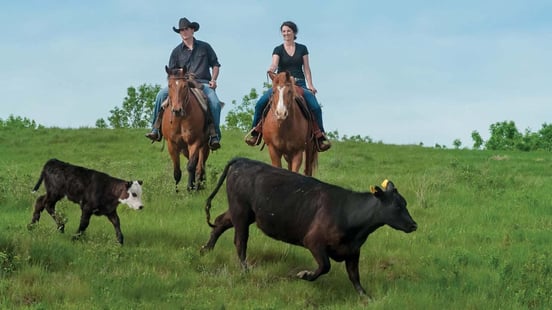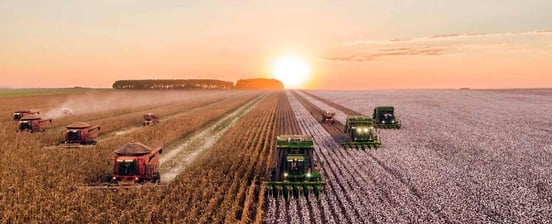

In a Nutshell: When small farmers in the United States need loans and credit products, they often turn to AgAmerica to meet their specific needs. The institution aims to expedite the approval of its loans and lines of credit. AgAmerica also emphasizes financial education through online resources and in-person interactions to ensure that farmers can maximize their funding. AgAmerica is on a mission to help small farms maintain operations and boost food security in the United States during typical times and challenging situations, including the COVID-19 pandemic.
According to US Farm Data, a marketing database of farms and ranches, about 671,000 farmers worked small-acreage farms in 2017. The data also shows that about 50% of farms bring in less than $10,000 in annual sales, with only 8% bringing in $500,000 or more.
But those small farms are a significant part of the U.S. supply chain. If those producers faltered due to financial issues, it could threaten the American food supply.
“Helping farms and farm families sustain themselves and grow the business is the most important thing we can do in this country,” said Curt Covington, Senior Director of Institutional Credit and Commodities Expert at AgAmerica. “If we don’t support the farm economy, food becomes a national security issue.”

For the past decade, AgAmerica has been on a mission to ensure that doesn’t happen. AgAmerica helps to keep food on tables and farmers at work by providing loans and credit products to small farmers.
In 2020, AgAmerica originated nearly $1 billion in agricultural mortgages. Of those transactions, around 40% were nonconventional products delivered to borrowers who had experienced hardships that required additional financial assistance. Access to those funds is crucial in keeping small farms productive.
“Most, if probably not all, farmers can’t sustain or grow their operation without some access to credit. It’s a very capital-intensive business, and it also has uneven cash flows,” Covington said. “There are certain sectors of agriculture where you plant your crop in the spring, and you don’t see any cash from that business until late September at the earliest, in some cases as late as November. So that requires a special set of financial solutions.”
Revolving Credit Lines Offer Efficiency and Flexibility
AgAmerica offers products across the lending spectrum, including a variety of short- and long-term loans. One of its most popular products is its revolving line of credit, through which borrowers can access and repay funds as they would with any loan. However, after they pay off the loan, they can immediately borrow again without going through a lengthy approval process.
“One of our most popular products is a 10-year, interest-only revolving line of credit that many farmers use to finance their operating needs,” Covington said. “It’s secured by the real estate, and they do not need to see their operating lender for 10 years. Many of our farmers find it refreshing, and as they harvest the crop and get their income, they can pay their credit down and have more funds available the next day.”

Farmers often turn to AgAmerica for its streamlined line of credit products.
That speed is also available with many of AgAmerica’s other products. AgAmerica can make a lending or credit decision with minimal information for some of its smaller and midsize loans.
That helps borrowers save time when preparing and submitting applications and makes processing much faster. Most receive a response within a day or two, enabling farmers to make fast decisions that can rapidly advance their businesses and livelihoods.
“What AgAmerica offers is speed of execution,” Covington said. “We have a deal team, an underwriting team, and opportunity teams that work very closely together. We focus on getting transactions through the pipeline and working through those bottlenecks, and so on. I’ve been in this business for 45 years, and I will tell you, I’ve never seen anything like it.”
Credit Products Bypass Underwriting to Provide Fast Funds
Although those fast-tracked products cut down on red tape and wait times by requiring a minimal amount of information, credit scores are still as crucial in agricultural lending as they are in mainstream consumer lending.
Credit reports are crucial components of any borrower’s application because they help lenders form a holistic picture of the borrower’s financial situation. That includes how much debt borrowers carry and the likelihood they can repay any additional debt they take on.
“It’s akin to somebody wanting to get a credit card, and they get instantaneous approval under a credit scoring model,” Covington said. “We have similar models inside AgAmerica lending that we use.”
Often, small farms need funds urgently. Waiting for the traditional underwriting process could be the difference between staying solvent and failing. While a single farm shutting its doors may not seem like a big deal, a wholesale closure of small farms across the nation could be disastrous for basic food security.
That’s why AgAmerica emphasizes speedy processing. Even if a farmer doesn’t qualify for a fast-tracked product, that doesn’t shut the door on approval.
“Those models help not only those with good, average, and excellent credit scores, but it’s also the starting point for those with credit scores that don’t quite meet muster,” Covington said. “If we look at a deal, and maybe it doesn’t quite meet the standards of that credit score, all it does is just push that credit underwriting into another slot for us. AgAmerica lending has very few transactions that end up not getting done because we have so many products and so many ways to get deals done.”
Financial Education Keeps Farmers Working
Accessible loans and credit lines won’t do much good if the borrower doesn’t know how to put them to good use. That’s not a problem specific to agricultural workers; financial literacy is lacking in the United States, and it often falls to financial institutions like AgAmerica to pick up the slack.
AgAmerica hosts a resource center on its website that includes relevant economic data and tools to help farmers assess and manage their funds. Between the two, farmers are in a better position to maintain the financial health of their operations and anticipate future needs.

AgAmerica helps farmers secure financing and offers tools to help them maximize their funding.
“Internet access has been an incredible benefit to agriculture with real-time ways of looking at how to deal with financial issues,” Covington said. “There are so many resources, and I think ours is one of the best out there.”
AgAmerica also supports educational opportunities at conferences and summits. It delivers valuable information to farmers while also learning more about relevant trends and industry concerns.
One of those concerns is succession planning to ensure farms preserve value to pass on to the next generation. Part of AgAmerica’s work is helping farm owners ensure the continuity of a business they’ve devoted their lives to building and maintaining.
“To me, there’s no better way of assisting a farmer than to say, ‘We’re not only here to help you, but we’re here to help the next generation,’” Covington said.
AgAmerica: Preparing Agriculture for a Fintech Future
One of the most significant challenges to small farm sustainability has been the disruption wrought by the COVID-19 pandemic. As the pandemic reached the United States in full force, supply chains began to falter along with farmer incomes. Without shipping and distribution to move food from farms to stores and restaurants, there were fewer sales and less money coming in.
Some farmers circumvented the problem through social networking and providing food directly to consumers. That cut out the middle man, but that also required more time and effort on their part. Others could not take advantage of that alternative income stream, so they turned to AgAmerica for continued financial assistance.
“There was also some disruption of credit flow, as I understand it. We didn’t see it here,” Covington said. “For AgAmerica lending, it was a very strong year.”
That attests to the strength of AgAmerica’s solutions. Other agricultural lenders seem to be following this example, particularly in the realm of rapid approval processes for loans and lines of credit. Covington expects to see fintech firms starting to close the gaps between existing methods and farmers’ needs for financial expedience.
That is especially true of agricultural appraisals. Covington said he expects to see valuation technology significantly reduce the time necessary for approval and underwriting, ensuring small farms have the funds they need when they need them.
“We get these deals done faster, better, and, and more efficiently,” Covington said. “AgAmerica’s an active player moving these kinds of concepts forward. And I realize that, if you’re talking residential lending, that’s old hat. But it’s not old hat in the agricultural space.”
Advertiser Disclosure
BadCredit.org is a free online resource that offers valuable content and comparison services to users. To keep this resource 100% free for users, we receive advertising compensation from the financial products listed on this page. Along with key review factors, this compensation may impact how and where products appear on the page (including, for example, the order in which they appear). BadCredit.org does not include listings for all financial products.
Our Editorial Review Policy
Our site is committed to publishing independent, accurate content guided by strict editorial guidelines. Before articles and reviews are published on our site, they undergo a thorough review process performed by a team of independent editors and subject-matter experts to ensure the content’s accuracy, timeliness, and impartiality. Our editorial team is separate and independent of our site’s advertisers, and the opinions they express on our site are their own. To read more about our team members and their editorial backgrounds, please visit our site’s About page.
